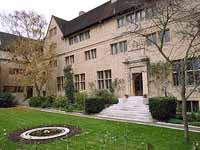|

| |
NEW LIFE IN OLD TRADITIONS
Please click here to subscribe to The
Way, Subscribers may download the whole of this issue here . You will need your subscriber number; if you have requested an electronic subscription a reminder of this number will have been e-mailed to you. Otherwise please e-mail us to obtain your number. Contents Timothy P. Muldoon In spiritual direction it is common to ask those being directed about desires they find within themselves, and to encourage them to bring these to God in prayer. Yet the word ‘desire’ in everyday speech often has a sexual connotation that can seem distant from, or even opposed to, Christian living. Tim Muldoon invites us to bridge these ideas by asking ‘How might I use my sexuality for the greater glory of God?’ Download this article in PDF format by clicking here Marion Morgan Following the Second Vatican Council a number of ancient institutions were revived within the Roman Catholic Church. One of these was the permanent diaconate, and another the Order of Consecrated Virgins. The latter is still poorly understood even within the Church. In our ‘Spirituality and Living’ strand, Marion Morgan explains what drew her to this particular way of life. Mary Frohlich Teresa of Avila is today recognised as one of the principal teachers of contemplative prayer within the Christian tradition. In her teaching she draws on her own experience of overcoming the challenges that she faced as she moved more deeply into prayer. Mary Frohlich analyzes one of these key challenges: the invitation Teresa heard to move into an imageless union with Christ. Nerea Alzola Articles and books have been written to consider how the Spiritual Exercises of St Ignatius might be adapted when the one making these Exercises is a woman. In this article, reprinted from Manresa, Nerea Alzola provocatively asks whether there are similar adaptations to be made when the director is female. J-M. Laurent Jean-Michel Laurent concludes his series of three articles on priestly formation, published to mark the ‘Year for Priests’ called for by Pope Benedict. Here he looks at how the personal discernment of a call made by the candidate for priesthood is best integrated with that discerning process carried out by those responsible for his seminary formation. Adolfo Chércoles In writing his Spiritual Exercises Ignatius gradually evolved a number of technical terms to describe the process the retreatant would undergo. To understand the Exercises more fully, it can be important to trace the development of these terms. Here one of the foremost contemporary Spanish givers of the Exercises asks what Ignatius means when he speaks of ‘inner knowledge’. Lysanne Sizoo Some years ago The Way published an article describing an initiative that offered thirty-day retreats in Swedish prisons. This was so successful that the team responsible are now taking the further step of establishing a monastic community within the prison itself. Lysanne Sizoo reports on a visit to the men involved in setting up that community. Tessa Frank Margery Kempe was a fourteenth-century English mystic, who dictated an autobiography detailing her religious quest. Tessa Frank argues that as she was neither a member of a religious order nor a recluse, but an urban lay-woman, her writings provide a unique insight into a spirituality shaped by the burgeoning commercial cities and towns; a spirituality that retains its relevance today. Book Reviews on the theology of religionson science and religion, and on applied ethics on finding happiness on the Seven Deadly Sins on a aposthumous collection of essays by Raymond E. Brown the academic study of spirituality From the Foreword THE CHRISTIAN CHURCH can be understood to draw its common understanding of the faith from three sources: scripture, tradition and those strands of contemporary teaching that are recognised as authoritative. The various branches of the Church give different weightings to these three elements; indeed, it is often this that serves most effectively to divide them. Nevertheless, whatever balance is arrived at has its own particular strengths and weaknesses. Where tradition is given a prominent place, one of those weaknesses can be a tendency to become hidebound, slow to respond appropriately to contemporary developments within society. So any Church needs its prophets, those who are prepared, even at some cost to themselves, to ‘think outside the box’. Each of the eight contributors to this edition of The Way illustrates something of such thinking, as it has been experienced in the past or as it applies to issues faced by people of faith today. It is noticeable that none of the writers is strident or dogmatic: they are principally concerned to bear witness to different ways of understanding. Yet there are presented here approaches to sexuality, urban living, patterns of prayer and priestly formation (to single out just four areas) that, if taken up and developed, could transform the Church’s self-understanding.Mary Frohlich focuses on a period in the life of the Spanish mystic Teresa of Avila when she was challenged to move beyond the imaginative prayer that had sustained her in her relationship with God to that point. Now something new was being asked of her, something that it took her time to assimilate and appropriate. Many continue to benefit from Teresa’s attempts to understand this change. An area where it can appear that the Christian Churches and contemporary Western society are most at odds is that of sexuality. In opposition to those who would argue that sexual desire is above all to be constrained or controlled, Tim Muldoon believes that the Spiritual Exercises can put this passionate side of human nature at the service of God. Adolfo Chércoles investigates the idea that the Exercises can offer knowledge of a different kind from that arrived at by science. And from an angle that is likely to seem yet more foreign to present-day secular society, Marion Morgan outlines the path that has led her to be happy to be identified as a ‘consecrated virgin’. At times patterns of thought change because the experience of those doing the thinking is different from before. It is notoriously difficult to describe how the thought processes of men and of women differ without falling into cliché. Yet most would recognise that there are some such differences, and Nerea Alzola asks what new approaches might be uncovered when it is women who are leading others in retreat. The sometimes contrasting perspectives on discernment of a candidate for priesthood and the one responsible for his formation are the subject of the third of Jean-Michel Laurent’s reflections. Finally, to speak of spirituality often conjures up images of quiet rural idylls, remote monasteries, distant pilgrimages or pastoral retreat houses. Here, our ‘thinking outside the box’ encompasses the desire of the medieval autobiographer and mystic Margery Kempe to live a profound life of prayer in the midst of a busy commercial centre as well as a project, described by Lysanne Sizoo, to establish a kind of monastic community within prison walls. Jesus told his disciples that ‘Every scribe who has been trained for the kingdom of heaven is like the master of a household who brings out of his treasure what is new and what is old’ (Matthew 13:52). The Church is perhaps better known for safeguarding ‘what is old’, valuing tradition and working hard to pass it down to subsequent generations. The challenge of bringing out ‘what is new’ demands the kind of innovative thinking across a broad range of issues that is represented here. If anything presented can inspire the reader to ‘think outside the box’ in a similar way, this edition of The Way will have well served its purpose. Paul Nicholson SJ
Please click here to subscribe to The
Way, | ||
| |






|


